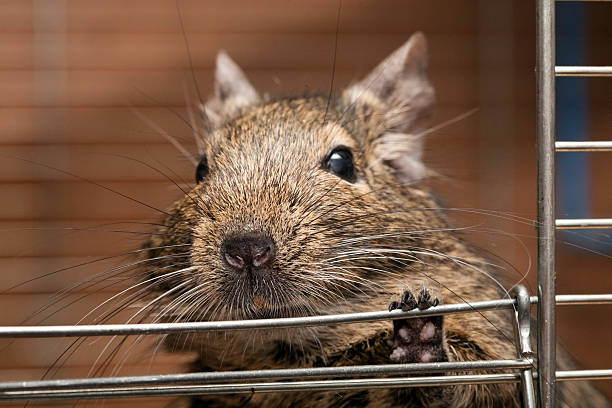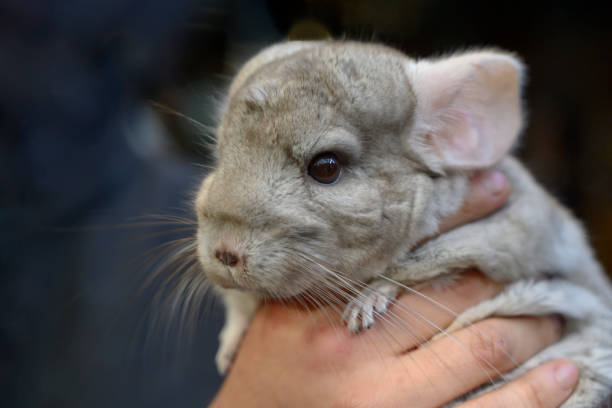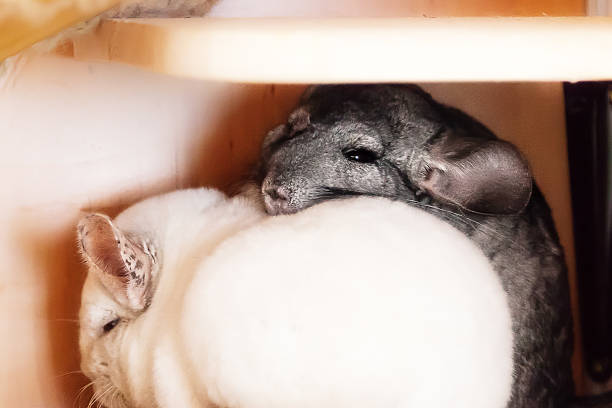How Can You Create the Perfect Chinchilla Habitat? Tips on Cages, Accessories, and More
This post contains affiliate links. This means I will make a commission at no extra cost to you should you click through and make a purchase. Read the full disclosure here.
Welcoming a chinchilla into your home is an exciting endeavour. One of the most important aspects of their care is providing them with a comfortable and stimulating habitat..
Create the perfect chinchilla habitat by selecting a spacious wire cage with appropriate bar spacing, providing essential accessories like wooden ledges and hiding spots, and maintaining optimal temperature and humidity levels.
Ensure proper grooming, engage in enriching play, and foster a strong bond through gentle interactions, resulting in a happy and healthy life for your chinchilla companion.
If creating the ideal chinchilla habitat feels overwhelming, don’t worry—I’ll guide you through everything you need step by step.

Choosing the Right Cage
Selecting the appropriate cage is the first step in creating the perfect habitat for your chinchilla. A well-chosen cage provides the foundation for comfort, safety, and overall happiness. Here’s what to consider when choosing the right cage for your furry friend:
Factors to Consider
- Size and Dimensions: Chinchillas are active animals that need room to move and explore. Opt for a cage with ample space for them to climb, jump, and play. A larger cage allows for more natural movement and better overall well-being.
- Bar Spacing and Material: The spacing between cage bars should be narrow enough to prevent your chinchilla from squeezing through. Wire cages are preferred because they provide ventilation and allow your chinchilla to climb the bars.
- Multi-Level Design: Chinchillas love to explore different heights. Look for a multi-level cage with platforms, ramps, and ledges. This design encourages their natural instincts and provides mental stimulation.
Benefits of Wire Cages
Wire cages offer several advantages for chinchilla habitats:
- Ventilation: Proper airflow helps regulate temperature and prevents moisture buildup, reducing the risk of respiratory issues.
- Visibility: Wire cages allow you to observe your chinchilla easily and provide them with a clear view of their surroundings.
- Climbing Opportunities: The horizontal bars of wire cages provide surfaces for climbing, an essential activity for chinchillas.
Avoiding Potential Hazards
While choosing a cage, keep in mind these potential hazards to ensure your chinchilla’s safety:
- Bar Spacing: As mentioned earlier, ensure the bar spacing is appropriate to prevent escapes.
- Sharp Edges: Check for any sharp edges or points that could harm your chinchilla.
- Plastic Components: Minimize the use of plastic components, as chinchillas are natural chewers and might damage or ingest plastic.
By carefully considering these factors and selecting a cage that aligns with your chinchilla’s needs, you’re laying the foundation for a comfortable and stimulating habitat. In the next section, we’ll explore how to furnish the chinchilla cage with accessories that enhance their living space and encourage natural behaviors.
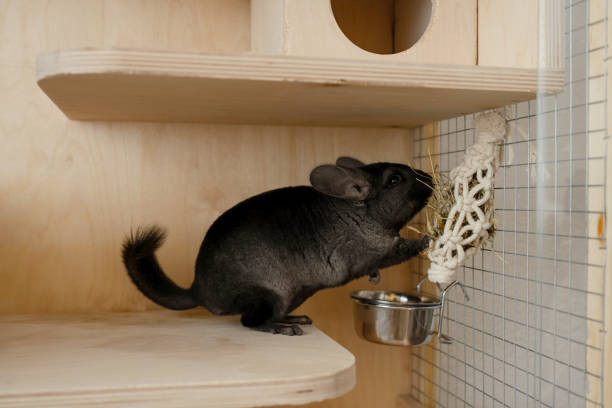
Furnishing the Chinchilla Cage
Once you’ve chosen the right cage, it’s time to transform it into a cozy and enriching home for your chinchilla. Furnishing the cage with appropriate accessories not only provides entertainment but also supports their natural behaviors and instincts. Let’s delve into the essentials of furnishing your chinchilla’s habitat:
Wooden Ledges and Platforms
Wooden ledges and platforms are fundamental for a chinchilla’s habitat. They offer climbing opportunities, serve as resting spots, and mimic the elevated perches chinchillas seek in the wild. Ensure the wood is untreated and safe for chewing to prevent any potential harm.
Chinchilla-Safe Hideouts and Nesting Spots
Creating hiding places within the cage allows your chinchilla to retreat when they need privacy or a sense of security. Choose hideouts made from natural materials like wood or hay. These spaces also serve as cozy sleeping spots.
Incorporating Tunnels and Tubes
Chinchillas love to explore tunnels and tubes, which mimic the burrows they would use in their natural habitat. These additions encourage movement and provide mental stimulation. Look for options that are appropriately sized and made from safe materials.
Chinchilla-Friendly Chew Toys
Chinchillas have continuously growing teeth, making chewing an essential activity. Provide wooden chew toys to help them wear down their teeth naturally and prevent dental issues. Choose toys without any toxic coatings or finishes.
By thoughtfully incorporating these accessories into your chinchilla’s habitat, you’re creating an environment that mirrors their natural behaviors and encourages healthy interactions.
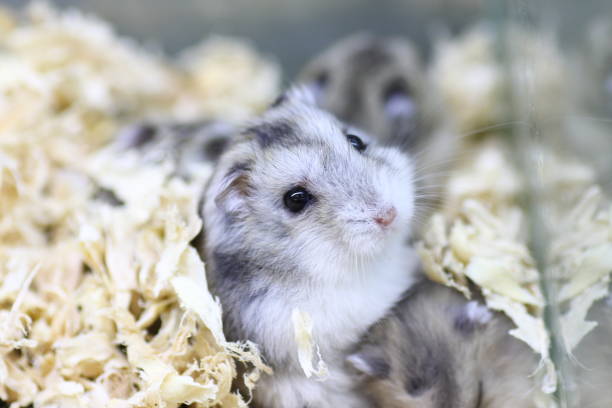
Providing Proper Bedding
Creating a comfortable and hygienic bedding environment is crucial for your chinchilla’s well-being. Proper bedding not only enhances their comfort but also contributes to a clean and odor-free habitat. Let’s explore the key considerations for selecting the right bedding materials:
Safe and Appropriate Bedding Materials
Chinchillas are sensitive creatures, and their bedding should be safe and non-toxic. Consider these suitable bedding options:
- Paper-Based Bedding: Soft, absorbent, and dust-free, paper-based bedding is a popular choice for chinchillas. It provides a comfortable surface for your chinchilla to rest and play.
- Aspen Wood Shavings: Aspen wood shavings are another option that is safe and has minimal dust. They offer a natural scent and can help control odors.
Maintaining Cleanliness and Odor Control
Regular cage cleaning and bedding changes are essential to prevent the buildup of waste and odors. Chinchillas are clean animals, and maintaining a hygienic environment supports their overall health. Aim to change bedding materials at least once a week, or more frequently if needed.
Avoiding Dusty or Fragrant Bedding
Chinchillas have sensitive respiratory systems, so it’s important to avoid bedding materials that are too dusty or have strong fragrances. Bedding with excessive dust or scent can cause respiratory discomfort and other health issues.
By choosing the right bedding materials and maintaining a clean environment, you’re ensuring that your chinchilla’s habitat is a cozy, comfortable, and healthy place for them to thrive. In the upcoming section, we’ll explore the crucial topic of temperature and humidity considerations, as these factors play a significant role in your chinchilla’s well-being.
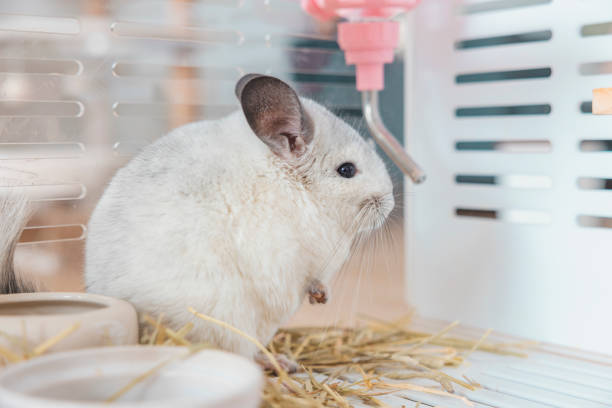
Temperature and Humidity Considerations
Maintaining appropriate temperature and humidity levels in your chinchilla’s habitat is essential for their health and comfort. Chinchillas are adapted to cooler environments, and their habitat should mimic their natural conditions to ensure their well-being. Here’s what you need to know:
Chinchillas’ Sensitivity to Heat and Humidity
Chinchillas are highly sensitive to heat and humidity, which can lead to heat stress and respiratory problems. Their dense fur coat prevents effective cooling, making them prone to overheating. Avoid exposing them to temperatures above 75°F (24°C) and humidity levels above 50%.
Ideal Temperature Range
The ideal temperature range for chinchillas is between 60°F and 70°F (15.5°C – 21°C). Keeping their habitat within this range helps prevent heat stress and maintains their comfort. Use a thermometer to monitor the temperature regularly.
Preventing Drafts and Sudden Temperature Changes
While maintaining the right temperature is important, also be cautious of drafts and sudden temperature fluctuations. Drafts can cause chinchillas to become chilled, leading to health issues. Place the cage away from windows, doors, and vents to avoid exposure to drafts.
Cooling Options
In warmer months or climates, provide cooling options for your chinchilla. Ceramic tiles or granite slabs can be placed in the cage to offer a cooler surface for them to rest against. You can also freeze a water bottle and wrap it in a cloth for them to lean against.
Monitoring Humidity

Humidity levels should be kept low to prevent respiratory issues and fungal infections. Use a hygrometer to measure humidity levels in the chinchilla’s environment. If humidity levels rise, consider using a dehumidifier to maintain a suitable range.
By understanding and managing temperature and humidity factors, you’re ensuring that your chinchilla’s habitat is comfortable, safe, and supportive of its natural needs.
Dust Bath Area
Chinchillas are known for their unique grooming ritual called the dust bath. This essential behavior helps them maintain their fur’s cleanliness and health. Providing a dedicated dust bath area in your chinchilla’s habitat is not only entertaining but also vital for their overall well-being. Here’s everything you need to know:
The Importance of Dust Baths
Chinchillas lack sweat glands, and instead of water, they use special volcanic dust to clean their fur. This dust absorbs excess oils and moisture, preventing their dense fur from becoming matted or dirty. Regular dust baths help maintain the quality of their coat and prevent skin issues.
Choosing a Suitable Dust Bath Container
Select a shallow container specifically designed for dust baths. It should be large enough for your chinchilla to comfortably roll around in. Ceramic, glass, or metal containers are preferred as they are easy to clean and won’t absorb moisture.
Frequency and Duration of Dust Baths
Offer your chinchilla a dust bath 2-3 times a week. Place a small amount of chinchilla-specific dust in the container and let your chinchilla roll and frolic in it for about 10-15 minutes. Avoid leaving the dust bath in the cage for extended periods to prevent soiling.
Observing the Dust Bath Ritual
Chinchillas thoroughly enjoy their dust baths and will display playful behavior during this time. They may roll, kick, and flip in the dust, ensuring it reaches all parts of their fur. It’s a delightful sight to behold and is a critical part of their grooming routine.
Cleaning and Maintenance
Regularly clean the dust bath container and replace the dust as needed. Be sure to remove any waste or debris that might accumulate during the bath. This ensures that your chinchilla’s dust bath area remains clean and effective.
By providing a designated area for dust baths, you’re not only catering to your chinchilla’s grooming needs but also adding an element of joy and enrichment to their daily routine.

Cage Placement and Creating a Stress-Free Environment
Where you position your chinchilla’s cage within your home can significantly impact their well-being and comfort. Creating a stress-free environment is essential to ensure that your chinchilla feels secure and at ease in their habitat. Here’s what you need to know about cage placement and minimizing stress:
Selecting a Suitable Location
- Quiet and Low-Traffic Area: Choose a location that is quiet and away from high-traffic areas. Chinchillas are sensitive to loud noises and sudden movements, so a peaceful environment helps them feel safe.
- Avoiding Direct Sunlight: Position the cage away from direct sunlight, as chinchillas are sensitive to heat. Sunlight can raise the temperature within the cage and potentially cause heat stress.
Preventing Stressful Interactions
- Pets and Other Animals: Keep your chinchilla’s cage away from areas where other pets or animals might stress them out. Predatory instincts in other animals can cause unnecessary anxiety for your chinchilla.
- Temperature Fluctuations: Avoid placing the cage near doors or windows that can expose your chinchilla to drafts and temperature changes.
Creating a Consistent Routine
- Scheduled Interactions: Interact with your chinchilla at consistent times each day. This routine helps them anticipate positive interactions and minimizes stress.
- Limiting Noise and Disturbances: Try to keep loud noises and sudden disturbances to a minimum. Chinchillas are more at ease in a calm and predictable environment.
Providing Hiding Spots
- Hideouts and Nests: Furnish the cage with hiding spots and nests where your chinchilla can retreat when they feel the need for privacy or security.
- Quiet Time: Ensure your chinchilla has dedicated quiet hours when they can rest undisturbed. This helps them maintain their natural sleep patterns.
By thoughtfully considering cage placement and creating a stress-free environment, you’re providing your chinchilla with optimal conditions for comfort and well-being.
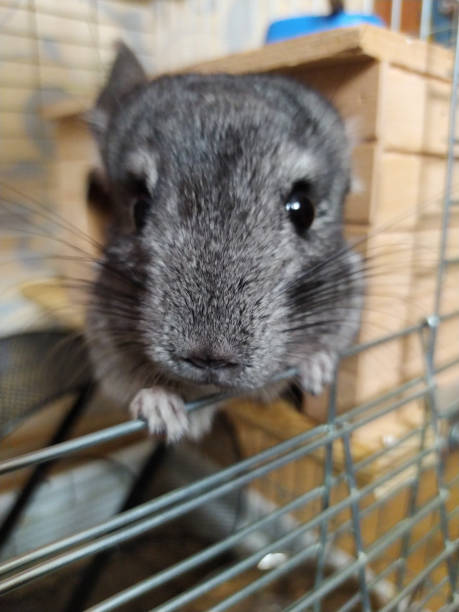
Enrichment and Play Elements
Enriching your chinchilla’s habitat with engaging activities and opportunities for play is essential for their mental and physical well-being. Chinchillas are naturally curious and active creatures, and providing them with ways to explore, exercise, and express their instincts contributes to a happier and healthier life. Here’s how to create an enriching environment:
Creating an Enriching Environment
- Wooden Ledges and Platforms: Incorporate wooden ledges and platforms at varying heights to encourage climbing and jumping. These mimic natural perches and offer opportunities for exploration.
- Chew Toys: Chinchillas have a strong urge to chew. Offer safe wooden chew toys to keep their teeth healthy and provide an outlet for their chewing behavior.
Suitable Toys and Activities

- Cardboard Hideouts: Provide cardboard tunnels, boxes, and hideouts for your chinchilla to explore and nest in. These can be replaced as needed to maintain a fresh environment.
- Hanging Platforms and Hammocks: Chinchillas enjoy hanging platforms and hammocks that encourage balancing and climbing. Make sure they are securely attached to prevent accidents.
Playtime Outside the Cage
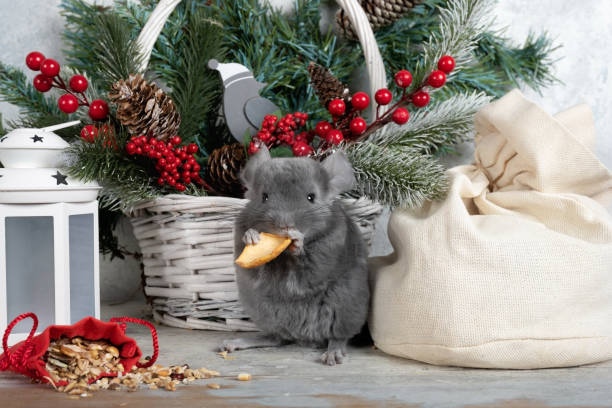
- Supervised Play Area: Set up a chinchilla-proofed area outside the cage for supervised playtime. Include ramps, tunnels, and toys to keep them engaged and active.
- Exploration and Interaction: Use playtime to bond with your chinchilla. Gently introduce new toys, encourage them to climb, and interact through treats and gentle play.

Rotating Toys and Accessories
- Preventing Boredom: Chinchillas can become bored with the same toys and accessories. Regularly rotate their toys to keep their environment fresh and exciting.
- Introduce Novelty: Introduce new toys or rearrange their habitat to provide novel experiences that stimulate their curiosity and exploration.
By focusing on enrichment and play, you’re providing your chinchilla with a stimulating and engaging environment that encourages natural behaviors and mental stimulation.

Socializing and Bonding with Your Chinchilla
Building a strong bond with your chinchilla is a rewarding journey that requires patience, trust, and understanding. Chinchillas are social animals that can form deep connections with their human companions. Here’s how to effectively socialize and create a meaningful relationship with your chinchilla:
Understanding Chinchilla Behavior Traits
- Observation: Spend time observing your chinchilla’s behavior. Understand their body language, preferences, and moods to respond appropriately.
- Respect Personal Space: Give your chinchilla space and time to approach you. Avoid overwhelming them with sudden movements or constant interactions.
Socializing and Handling Chinchillas

- Gentle Approach: Approach your chinchilla calmly and with patience. Offer your hand for them to sniff and get used to your scent before attempting any physical interaction.
- Hand-Feeding Treats: Build trust by offering treats from your hand. This creates positive associations with your presence and helps them feel comfortable around you.
Providing Mental and Physical Stimulation

- Interactive Play: Engage in interactive play with your chinchilla. Use toys and games that encourage them to climb, jump, and explore.
- Talking to Your Chinchilla: Regularly talk to your Chinchilla in a calm and soothing voice. This helps them become familiar with your voice and presence.
Recognizing Individual Personalities
- Unique Personalities: Understand that each chinchilla has its own personality. Some may be more outgoing, while others are more reserved. Respect their individual traits.
- Building Trust: Building trust takes time. Be patient and consistent in your interactions, allowing your chinchilla to approach you at their own pace.
Bonding Through Treats and Affection
- Treat Time: Use treats as a tool for bonding. Gradually, your chinchilla may take treats from your hand, strengthening the bond between you.
- Gentle Petting: Once your chinchilla is comfortable with your presence, try gentle petting. Start with their back and gradually explore areas they enjoy being touched.
Creating a strong bond with your chinchilla enriches both your lives and allows you to provide the best care possible. With patience, understanding, and respect for their individuality, you can forge a deep connection that leads to a harmonious and loving companionship.
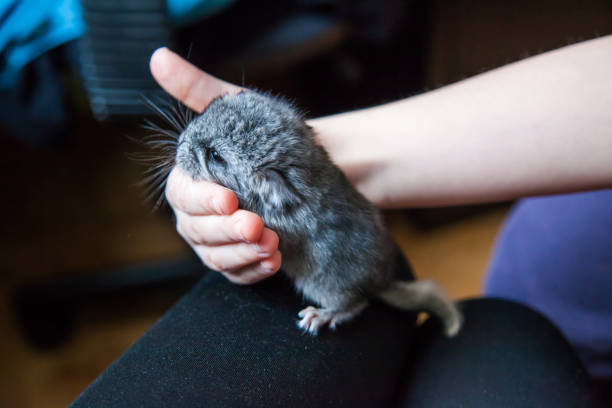
Grooming and Hygiene: Keeping Your Chinchilla Clean and Healthy
Maintaining proper grooming and hygiene practices for your chinchilla is essential to ensure their health and well-being. Chinchillas have unique grooming needs, and a clean and well-maintained coat, nails, and teeth are crucial for their overall comfort. Here’s how to keep your chinchilla looking and feeling their best:
Importance of Dust Baths
- Natural Grooming: Chinchillas have an instinctual need for dust baths to keep their fur clean and remove excess oils and moisture.
- Providing Dust Baths: Set up a dedicated dust bath area as discussed earlier. Offer dust baths a few times a week to support their grooming routine.
Nail Trimming and Coat Maintenance

- Regular Nail Checks: Chinchillas’ nails can grow long and become problematic if left untrimmed. Check their nails regularly and trim as needed using appropriate pet nail clippers.
- Maintaining a Clean Coat: Chinchillas are generally clean animals, but sometimes their fur can become soiled. Gently remove any debris from their fur to prevent matting.
Dental Care and Preventing Dental Problems

- Chinchilla’s Dental Anatomy: Chinchillas have continuously growing teeth. Providing proper chewing opportunities and a healthy diet is essential to prevent dental issues.
- Chew Toys: Offer a variety of safe wooden chew toys to help them wear down their teeth naturally and prevent overgrowth.
Regular Health Check-ups
- Veterinary Visits: Schedule regular visits to a chinchilla-savvy veterinarian to ensure your pet’s overall health. Discuss dental care, vaccinations, and any concerns you may have.
- Signs of Illness: Be vigilant about observing changes in your chinchilla’s behavior, appetite, and activity level. Early detection of health issues is crucial for timely treatment.
Preventing Overbathing
- Balancing Bath Frequency: While dust baths are important, overbathing can lead to dry skin. Follow a schedule and avoid excessive dusting.
- Monitoring Skin and Coat: Keep an eye on your chinchilla’s skin and coat condition. If you notice any dryness or irritation, adjust their bathing routine.
By prioritizing grooming and hygiene, you’re ensuring that your chinchilla’s physical health is well-maintained. Regular grooming sessions and appropriate care practices will contribute to a healthy, happy, and comfortable life for your furry friend.

Reproduction and Breeding Considerations
Reproduction and breeding in chinchillas require careful planning, knowledge, and a commitment to responsible practices. If you’re considering breeding chinchillas, it’s essential to understand the complexities involved and prioritize the health and well-being of both the parents and potential offspring. Here’s what you need to know:
Reproductive Behaviors of Chinchillas

- Maturity: Chinchillas reach sexual maturity between 8 to 12 months of age, depending on factors like genetics and nutrition.
- Breeding Season: Chinchillas do not have a strict breeding season but can reproduce year-round. However, it’s important to consider the well-being of both parents before proceeding with breeding.
Responsible Breeding Practices and Considerations

- Health Screening: Ensure that both the male and female chinchillas are in optimal health before breeding. Schedule a veterinary check-up to identify any potential health issues.
- Genetic Diversity: Breeding should aim to promote genetic diversity and avoid inbreeding, which can lead to health problems in offspring.
- Pairing Compatibility: Match chinchillas with compatible temperaments and personalities to reduce stress and conflict during the breeding process.
Caring for Chinchilla Kits

- Pregnancy and Birth: Chinchilla pregnancies last about 111 days. Be prepared for the birth and ensure that the mother has a safe and quiet space to give birth.
- Nurturing Kits: Chinchilla mothers are generally attentive to their kits, but it’s important to monitor them and provide support if necessary. Avoid excessive human intervention during this sensitive time.
Breeding chinchillas is a significant responsibility that requires careful planning, knowledge, and a deep commitment to the animals’ welfare. If you’re considering breeding, make sure to thoroughly research, consult with experts, and prioritize the health and happiness of both the parents and potential offspring.

Final Thoughts
As you embark on this journey of chinchilla companionship, remember that the joy and companionship they bring into your life are immeasurable. Your efforts to provide the best possible care contribute to a lifetime of happiness for both you and your chinchilla. Whether it’s the playful antics during dust baths or the heartwarming moments of bonding, your chinchilla’s presence is a true treasure.



